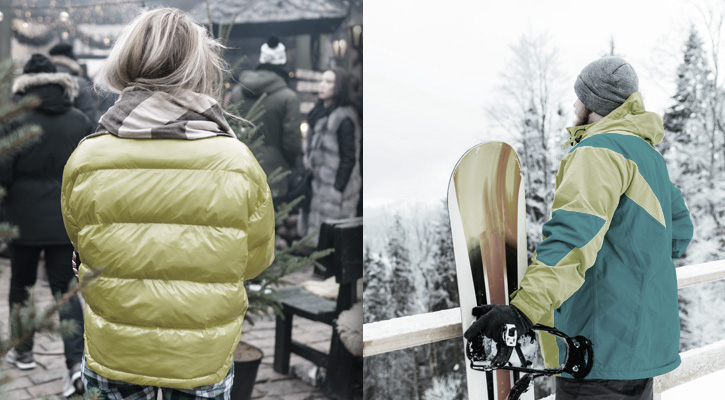
As winter approaches, many of us are on the lookout for a new insulated jacket to keep us warm during the cold days ahead.
With so many options available, it can be difficult to decide which one is the best fit for you. However, the most important aspect of any winter jacket is its insulation.
In this article, we’ll compare the two most common types of insulation: Down and Synthetic insulation.
We’ll explore the pros and cons of each, and ultimately determine which one is the better choice for your needs.
So, let’s dive in and find out which jacket insulation is best!
Key Points:
- Down insulation is a natural insulator sourced from waterfowl, and it has exceptional insulating properties that are hard to replicate.
- Synthetic insulation is typically made of polyester and closely replicates down’s ability to trap heat.
- Down insulation is unmatched in terms of loft, warmth, and comfort, but it is susceptible to moisture, and it requires meticulous care.
- Synthetic insulation performs much better in wet conditions, is easy to care for, and tends to be less expensive than down insulation.
- A down jacket is best for very cold and dry weather, while synthetic insulation is ideal for seasonal jackets, wet weather, and for those opposed to animal-sourced clothing.
1. Down
Down insulation is often regarded as the superior choice due to its exceptional insulating properties that are hard to replicate. It is a natural insulator sourced from waterfowl like geese and ducks.
However, it’s not the only natural insulator available, wool is another option that has been used for centuries.
There are several types of down insulation available. Below we’ll also see why it’s widely considered the best insulation option for jackets.

Types of Down and Its Sourcing
It is important to note that down and feathers are not the same thing, as down is not technically a feather. It is the undercoating found in waterfowl that lies between the birds’ body and their outer feathers.
This insulation serves to keep the birds warm and also helps to keep their eggs warm by trapping warm air from the bird’s body between the tiny filaments to create a barrier against the cold.
There are two main types of down insulation sourced from birds: goose down and duck down.
Duck down is the more affordable option and is commonly used in jackets. However, it does not perform as well as goose down due to its higher weight-to-warmth ratio, meaning that more duck down is required to provide the same level of insulation as a similarly rated goose down jacket.
Goose down has a higher loft and weighs significantly less.
Most reputable brands use down that meets the Responsible Down Standard, ensuring that the down and feathers used are responsibly and sustainably sourced from birds that were humanely treated, neither force-fed nor live-plucked.
Down is usually a byproduct of the meat industry, and its origin can be traced from the birds’ hatching to the end of their lives.
Down Loft and Fill Power
Down loft and fill power are often used interchangeably as fill power is a measure of the loft. Loft refers to the fluffiness of down clusters, and the higher it is, the more warmth the clusters can trap.
Fill power measures the loft by determining how many cubic inches one ounce of down can “fill” when expanded to its maximum, and this measurement is typically listed on the label and in the details of down jackets.
For example, a 550 fill-power down jacket means that one ounce of down can occupy 550 cubic inches when expanded.
The higher the fill power, the better the insulation and the lower the jacket’s weight. Goose down is the loftiest of all types of down and can rate upwards of 900 fill power when sourced from mature geese.
However, the price of the jacket is proportional to the fill-power rating. Therefore, the higher the loft, the more expensive the jacket is likely to be.
Down Characteristics
In addition to its loft and ability to trap warm air, down insulation has several other characteristics that we will explore and compare to those of synthetic insulation.
Longevity is a notable advantage of down jackets, as they can last for decades with proper care and maintenance. However, caring for down jackets can be a challenging process.
Compressibility is another feature of down jackets that comes in handy when traveling or storing the jacket away during warmer weather. Goose-down jackets are particularly compressible as they are less bulky than other types of down.
One major downfall of down insulation is its susceptibility to moisture. When wet, down loses its loft and ability to trap heat, rendering it ineffective at insulating. To mitigate this issue, some manufacturers use DWR (Durable Water Repellent) down treatments to make the insulation water-resistant and reduce the risk of it becoming wet.
Read also: 7 Best Italian Down Jacket Brands for Winter
2. Synthetic
The quality of synthetic insulation improves over time as technology advances. This type of insulation is typically made of polyester and closely replicates down’s ability to trap heat, using small polyester fibers or clusters, depending on the type of insulation.
Let’s now explore the characteristics of synthetic insulation.

Types of Synthetic Insulation
As previously mentioned, synthetic insulation is typically made of polyester, but different brands have their unique methods of producing insulation. Some notable brands include:
PrimaLoft® is considered the “down” of synthetic insulators and is made of microfibers that are incredibly soft and perform similarly to down. This durable insulation provides the highest warmth-to-weight ratio of all synthetic insulation and is water-resistant and highly compressible.
Thermolite® is an excellent insulator with a high warmth-to-weight ratio and the ability to insulate even when wet. It comes in several variants that offer varying levels of performance and durability.
Polarguard® is made of continuous fibers that retain their loft even when wet. It is hypoallergenic and comes in three main variants with different compressibility and performance levels.
MicroLoft® is water-resistant and made of extremely thin fibers, allowing it to trap heat efficiently.
Synthetic Insulation Characteristics
While synthetic insulation is designed to perform similarly to down, it has several unique characteristics that are common among all types of synthetic insulation.
Water resistance is a notable advantage of synthetic insulation due to its polyester composition. Synthetic insulation can withstand moisture for longer periods than down and does not lose much of its loft even when wet. This allows it to insulate when wet, albeit to a lesser degree than when dry.
Mildew resistance is another benefit of synthetic insulation. Being synthetic, it is less prone to mold and mildew growth, especially since most synthetic insulators are designed to prevent these issues. However, it is still important to store synthetic insulation in dry conditions to avoid any potential issues.
Synthetic insulation is also easy to care for, as it can be washed easily and dries quickly with minimal effort.
Read also: Hardshell vs Rain Jacket: The Difference
3. Comparison
Let’s now see how the characteristics of down and synthetic insulation compare to each other.
Loft and Warmth
Down insulation is unmatched in terms of loft, regardless of how great synthetic insulation may be. It is the warmest insulator available and provides excellent loft and comfort.
This is why winter parkas designed for freezing conditions, including those for arctic expeditions, are typically made with down insulation.
Moisture Resistance
As we previously mentioned, down insulation loses all of its loft and insulating ability when wet. This may seem counterintuitive since down is sourced from waterfowl. However, these birds have thicker feathers over the down that are water-resistant and create a waterproof barrier to prevent the down from getting wet.
Fortunately, water-resistant and even waterproof down jackets have been developed to overcome this issue, although they may come at a higher cost.
In contrast, synthetic insulation performs much better in wet conditions and is more suitable for areas that experience frequent rain.
Maintenance and Care
Cleaning down insulation requires a meticulous process that is not necessarily complicated, but does require time and patience. Down-specific cleaners are recommended, and it is preferable to apply a water-repellent treatment after washing, particularly if the jacket’s shell is not effective in repelling water.
In contrast, synthetic insulation is easy to clean and dries quickly compared to down, which can take several days to dry completely.
Durability
Quality down jackets can outlast synthetic jackets by a significant margin with proper care.
Synthetic insulation tends to wear out over time, which is not the case with down insulation. As a result, synthetic insulation gradually loses its ability to insulate.
However, this is not necessarily a problem as high-quality jackets that use synthetic insulation can still last a long time, and they are typically less expensive than down jackets.
4. Which is Better?
Both down and synthetic insulation have their advantages and disadvantages, and the choice ultimately depends on your budget, lifestyle, and location.
If you live in an area with harsh and dry winters, a down jacket will keep you warm even in extremely cold temperatures. Additionally, if you are an avid outdoor adventurer who requires a high-quality jacket for hiking and camping trips, a down jacket will provide superior insulation and durability.
However, if you prefer seasonal jackets or are opposed to wearing animal-sourced clothing, synthetic insulation will suffice at a more affordable price.
